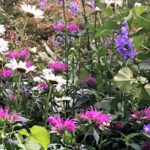The Bones of the Garden
Gardens crave order, underlying structure; they need it to thrive and look beautiful.
Whether that structure relies on geometric symmetry, as strictly enforced by the French and Italian garden styles, or on self-organizing hierarchies, as seen in cottage and English gardens, it is always there, the subtle framework which gets filled with color and texture.
We call this subtle structure the bones of the garden, and it comprises trees, shrubs, long-lived perennials, naturalized mass plantings, hardscaping, water features, any elements, mineral or alive, that don’t alter their appearance too much over the years.
I said they don’t change too much, but they will. Everything changes, there are no permanent things in this world we live in. Structures decay, plants die, even stone gets discolored in time. These changes are part of the charm of a perennial garden, and proof it is a living entity, a lovely collective being. Gardens age, just like we do, and, just like us, transform in the process.
Some perennials are so long lived we can consider them permanent: peonies live eighty years, hydrangeas fifty years, roses thirty five, hellebores twenty.
Most of the staples of professional landscaping, plants like Russian sage, daylilies, pinks, irises, sedums, hostas and coreopsis, are expected to last more than a decade.
Last, but not least, no garden is complete without perennial ground covers like vinca, ivy and sweet woodruff, the most useful and least appreciated long-lived landscaping elements.




 Previous Post
Previous Post Next Post
Next Post




